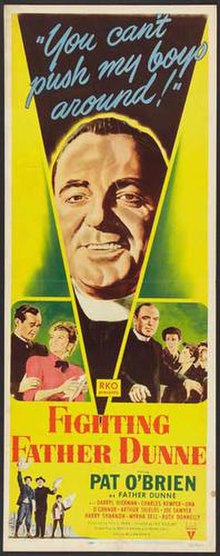Fighting Father Dunne
| Fighting Father Dunne | |
|---|---|

Theatrical poster of the film
|
|
| Directed by | Ted Tetzlaff |
| Produced by | Phil L. Ryan |
| Screenplay by |
Martin Rackin Frank Davis |
| Story by | William Rankin |
| Starring |
Pat O'Brien Darryl Hickman Charles Kemper Una O'Connor Arthur Shields Harry Shannon Joe Sawyer Myrna Dell Ruth Donnelly |
| Music by |
Roy Webb (composer) Constantin Bakaleinikoff (director) |
| Cinematography | George E. Diskant |
| Edited by | Frederic Knudtson |
|
Production
company |
|
|
Release date
|
|
|
Running time
|
93 minutes |
| Country | United States |
| Language | English |
Fighting Father Dunne is a 1948 American biographical film about the life of Father Peter Dunne, and the creation of his News Boys Home in St. Louis, Missouri. Directed by Ted Tetzlaff, the screenplay was written by Martin Rackin and Frank Davis, based on an original story by William Rankin. The film stars Pat O'Brien as Fr. Dunne, along with Darryl Hickman, Charles Kemper, Una O'Connor, Arthur Shields, Harry Shannon, Joe Sawyer, Myrna Dell, and Ruth Donnelly.
In St. Louis, renovations are about to begin on the News Boys' Home and Protectorate. Fred Carver approaches the men about to rip up the sidewalk out front, and asks that they preserve a slab of the sidewalk which contains two sets of footprints: his as a boy, and those of Father Dunne. The workers do not know who Father Dunne was, and Carver begins to relate the tale of the late priest, and creation of the building they stand in front of.
In 1905 St. Louis, newspapers employ young boys, many of them orphans to deliver their papers. One brutally cold morning, one of the homeless boys, falls ill and can't work. His two friends, Tony and Jimmy, not knowing what to do, go to Father Dunne's parish where they tell the priest of their concerns. Dunne accompanies the two youths to where their friend lives: in a cardboard box. After he takes the three boys to his sister Kate's house, he convinces her and her husband Emmett to take the boys in on a temporary basis until he can figure out a more permanent solution.
Dunne visits his Archbishop John Joseph Glennon and tells him of his intent to build a home for the newsboys and other children who live on the street. The Archbishop pledges to support Dunne's efforts, but makes it clear that the diocese is not in a financial position where they can contribute any money to the project. Undaunted, Father Dunne uses his winning personality and gifts of persuasion, to cajole, harangue, and otherwise convince local business people to support his project. Using the donations, Dunne rents a run-down townhouse, and begins to refurbish it, again convincing local businesses to donate the materials for the renovation. He also enlists the help of a local attorney, Thomas Lee, to help him in his negotiations, as well as providing free legal council.
...
Wikipedia
